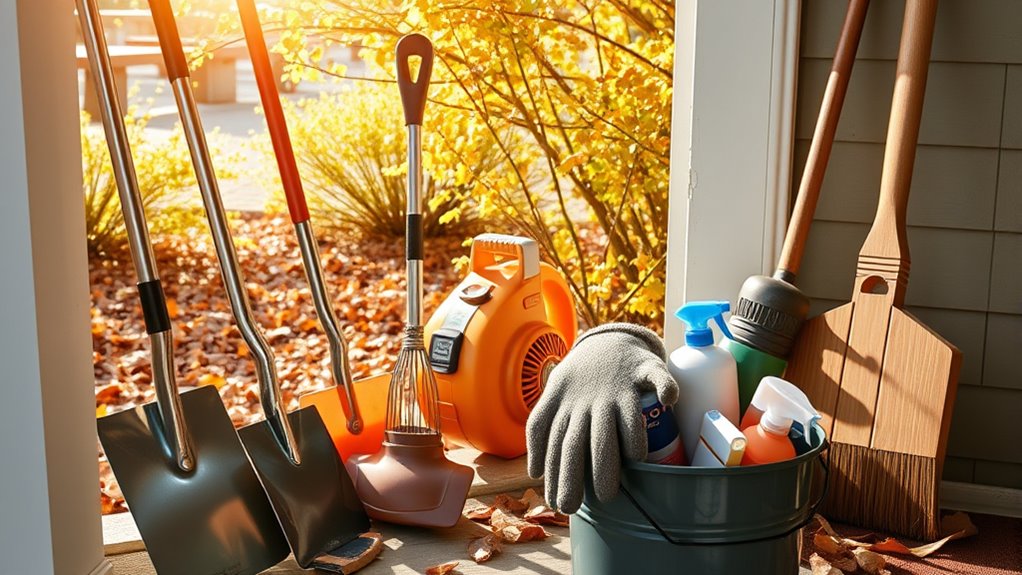As winter approaches, it’s vital to prepare your home. Start by inspecting the roof for leaks and cleaning gutters to prevent ice dams. Check for drafts around windows and doors, sealing any gaps you find. Confirm your HVAC system is inspected and air filters are clean for peak performance. Stock up on essential supplies for emergencies and clear walkways for safety. There’s more to guarantee you stay cozy and safe through the cold, so keep exploring.
Key Takeaways
- Inspect and repair roof shingles to prevent leaks and structural damage during winter storms.
- Clean gutters and downspouts to avoid ice dams and direct water away from the foundation.
- Seal gaps around doors and windows to improve insulation and keep cold air out.
- Schedule an HVAC system inspection and clean air filters to maintain warmth and energy efficiency.
- Create an emergency kit with essentials like food, water, and flashlights for winter emergencies.
Preparing Your Home’s Exterior for Cold Weather
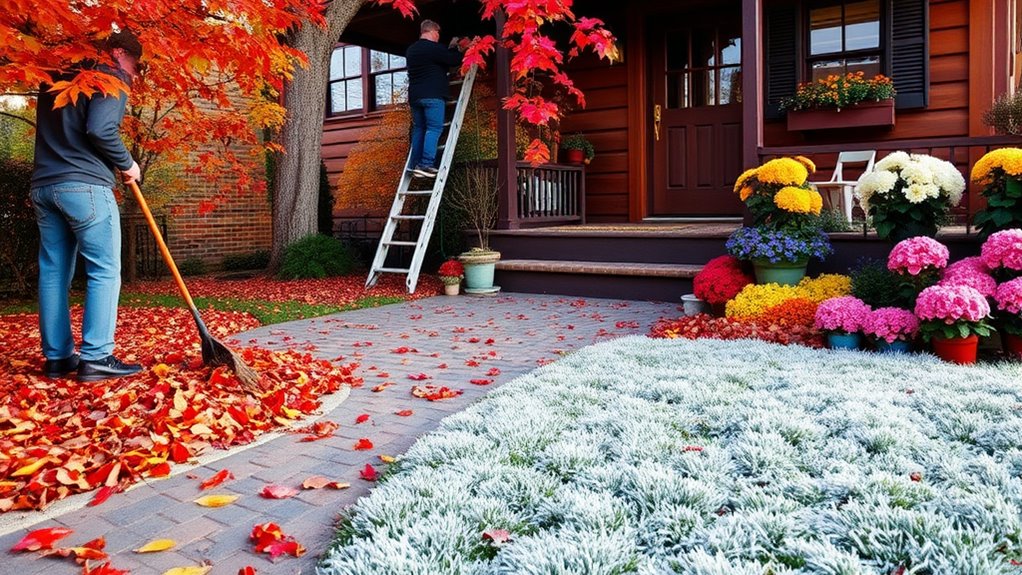
As winter approaches, it’s essential to prepare your home’s exterior to withstand the harsh conditions ahead.
Start by inspecting and repairing your roof shingles to prevent leaks and structural damage.
Next, clean your gutters and downspouts thoroughly to avoid ice dams, ensuring effective water runoff that directs water at least 5 feet away from your foundation.
Consider installing gutter guards to reduce maintenance and prevent clogs that can lead to water damage.
Don’t forget to seal any gaps around doors and windows to improve insulation and keep cold air out.
Finally, regularly check for signs of pest infestations, as cold weather drives pests indoors. Additionally, make sure to assess your farmhouse furniture to ensure it is properly stored or protected from the elements.
Taking these steps now will save you from costly repairs later.
Pinpointing Air Leaks and Enhancing Indoor Comfort
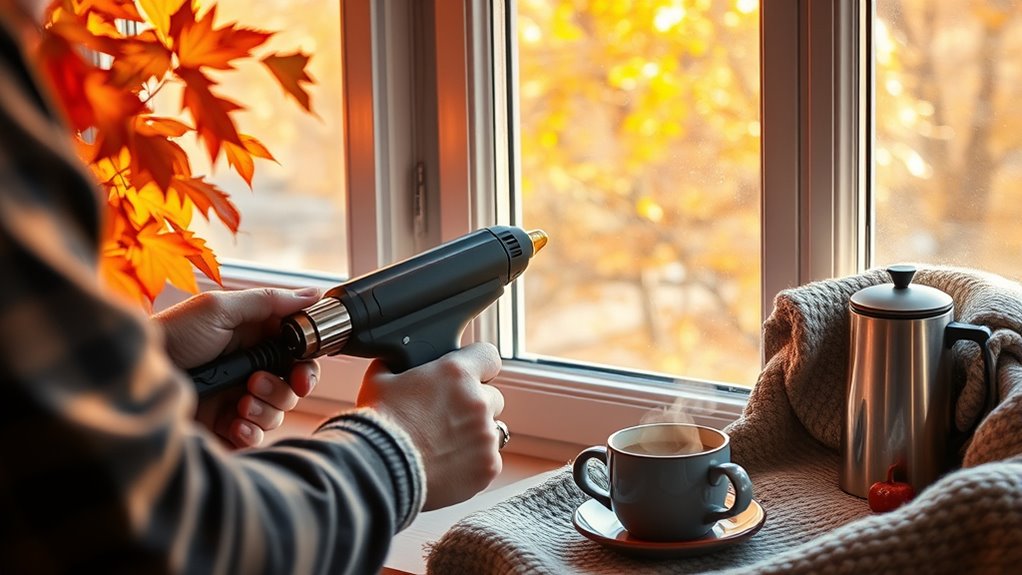
As winter approaches, it’s essential to pinpoint any air leaks in your home to keep it cozy and efficient.
You can easily identify drafts around windows, doors, and heating ducts using simple methods like wet hands or incense.
Once you locate these leaks, sealing them can make a big difference in your comfort and heating costs.
Detecting Air Leaks
Detecting air leaks is essential for maintaining a cozy home during the winter months, especially since even small gaps can lead to considerable heat loss. Start by checking your windows and doors for drafts using wet hands or incense. Common areas for leaks include:
| Area | Solution |
|---|---|
| Windows | Apply weatherstripping |
| Doors | Install insulating sweeps |
| Duct Joints | Inspect and seal gaps |
Evaluating your attic insulation is also vital; verify it’s adequately thick and not compressed to maximize energy efficiency. By identifying and addressing these leaks, you can greatly enhance indoor comfort and reduce energy costs this winter. Remember, sealing drafts not only keeps your home warm but also saves you money.
Sealing Drafty Areas
While you mightn’t see the small gaps that let cold air in, sealing drafty areas is essential for maintaining indoor comfort during winter.
Start by identifying air leaks around windows, doors, and duct joints using wet hands or incense. Once you’ve pinpointed the drafts, apply adhesive-backed EPDM rubber or foam weatherstripping to enhance energy efficiency.
Adding insulating sweeps to the bottoms of drafty doors will further help maintain a comfortable indoor temperature. Don’t forget to patch leaky seams in your ductwork with HVAC foil tape to reduce heat loss by up to 20%.
Finally, evaluate and upgrade your attic insulation to guarantee it meets the recommended R-value for ideal winter maintenance and proper insulation.
Essential Appliance and System Maintenance for Winter
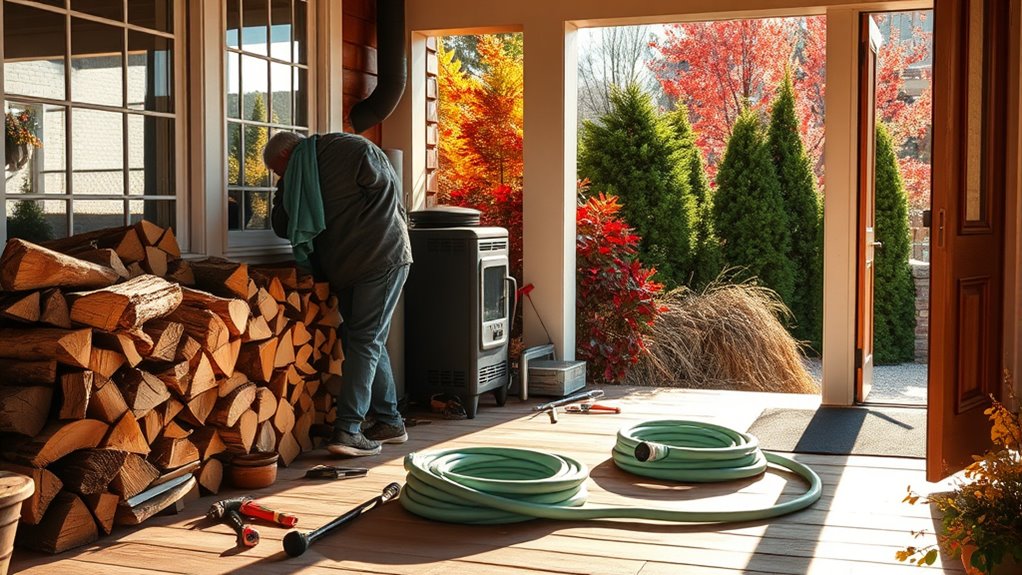
As winter approaches, it’s essential to give your HVAC system a thorough inspection and clean the air filters monthly to keep the air in your home fresh. Regular maintenance can help ensure that your heat pump operates efficiently and effectively throughout the colder months. Using an air purifier with HEPA filters can significantly enhance indoor air quality by capturing allergens and pollutants. Additionally, incorporating a heat pump into your home can lead to increased energy efficiency and lower operational costs during winter. Don’t forget to flush your water heater tank annually to maximize efficiency and extend its lifespan. Regular maintenance can reduce unexpected repair costs and guarantee your home stays comfortable all season long.
HVAC System Inspections
Before the winter chill sets in, scheduling an HVAC system inspection is essential for guaranteeing your home stays warm and energy-efficient.
Regular inspections help enhance HVAC systems’ efficiency, reduce energy costs, and prevent costly breakdowns during peak heating months. A professional inspection can identify potential issues, such as worn components or leaks in ductwork, which could lead to heat loss and increased energy bills. Additionally, it’s crucial to clean filters regularly to maintain optimal performance and air quality.
Furthermore, replacing air filters monthly ensures proper airflow and improves indoor air quality, especially when your home is sealed tight for winter. Cleaning the ducts can also remove dust and debris, further boosting system efficiency. Furthermore, maintaining your HVAC system can significantly improve air quality in your home, ensuring a healthier living environment during the colder months.
Water Heater Maintenance
With your HVAC system ready for the winter, it’s time to focus on another important aspect of home maintenance: your water heater.
Start by flushing the tank annually to remove sediment buildup, enhancing efficiency and extending its lifespan.
Check the pressure relief valve to verify it’s functioning properly; a faulty valve can lead to dangerous pressure buildup.
Inspect the anode rod, replacing it every 3-5 years to prevent corrosion.
Set your water heater temperature to 120°F to avoid scalding and reduce energy consumption.
Finally, look for any signs of leaks or moisture around the unit, as these can indicate issues that may require professional attention to prevent costly water damage.
Keep your water heater in top shape this winter!
Preparing for Power Outages and Winter Emergencies
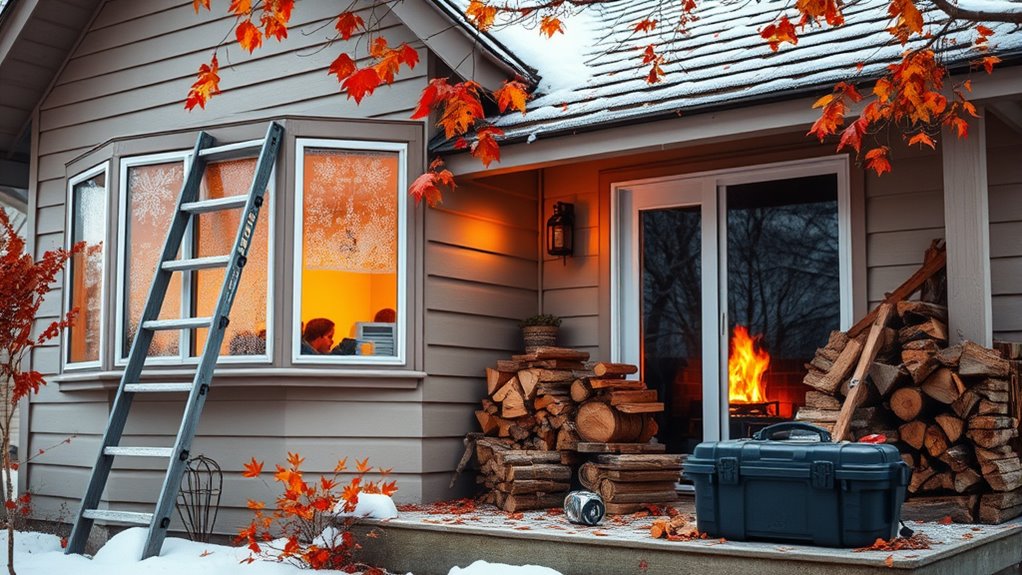
Preparing for winter emergencies, especially power outages, is essential for keeping your home safe and comfortable.
With power outages increasing, it’s vital to be ready. Here are three key steps to take:
- Create an emergency kit: Stock it with non-perishable food, water, flashlights, batteries, and a first aid supply to sustain your household during outages.
- Install carbon monoxide detectors: Place them on every floor and test their functionality regularly to prevent poisoning risks.
- Check smoke detectors: Verify they’ve fresh batteries to maintain safety during winter storms.
Outdoor Winter Safety and Vehicle Preparedness

As winter approaches, taking steps for outdoor safety and vehicle preparedness becomes essential to guarantee you navigate the season smoothly.
Start by stocking up on ice melt and sand to prevent slips and falls around your home and walkways. Prepare your snow removal equipment by servicing your snow blower and checking shovels, ensuring they’re ready for any snowstorms. Keep fuel on hand for efficient snow removal during heavy accumulations.
Stock up on ice melt, service your snow removal equipment, and keep fuel ready for efficient snow management this winter.
Assemble a winter car kit featuring an ice scraper, shovel, blankets, and non-perishable snacks for emergency situations. Additionally, make sure your vehicle is equipped with a first aid kit and extra warm clothing to handle potential breakdowns or emergencies in the cold.
Prioritize these steps for effective outdoor winter safety and vehicle preparedness.
Energy Efficiency Tips for Winter
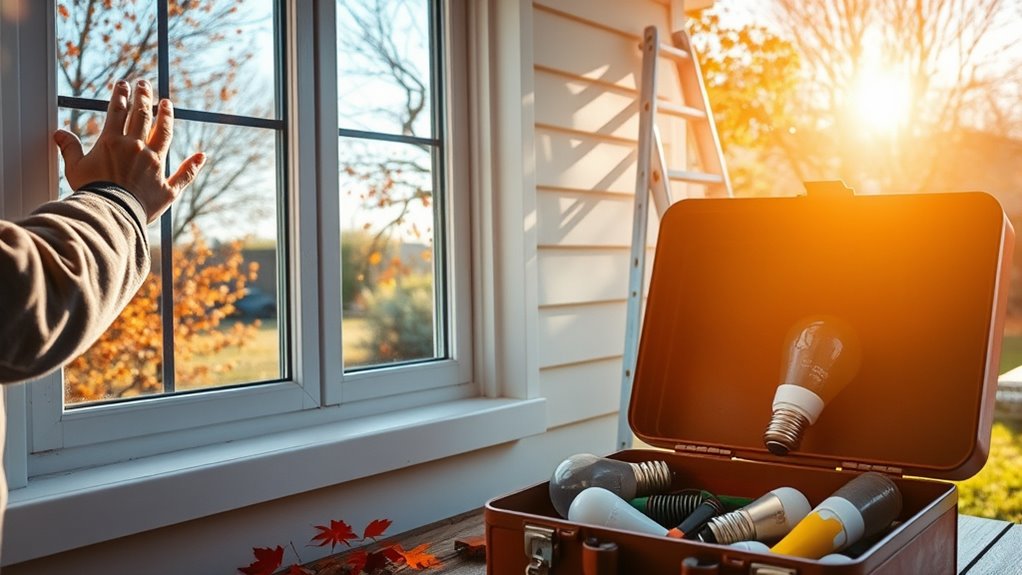
To stay warm and save money this winter, consider implementing energy efficiency tips that can greatly reduce your heating costs.
Here are three effective strategies:
- Seal air leaks around windows and doors to improve energy efficiency by up to 20%, which can considerably lower your heating demands. This can be especially beneficial when combined with energy-efficient systems that help reduce overall energy consumption.
- Add insulation in attics and walls to prevent heat loss, potentially saving an average of 15% on heating costs. Proper insulation works hand in hand with heat pumps, which utilize electricity more efficiently, converting it into heat.
- Utilize a programmable thermostat to automatically lower temperatures when you’re away or sleeping, reducing heating costs by up to 10-15%.
Additionally, using thermal window treatments can cut heat loss by up to 50%. Implementing these strategies can also enhance your indoor air quality, as air purifiers can help reduce allergens and improve overall well-being during the winter months.
Frequently Asked Questions
What’s the Most Overlooked Home Maintenance Task?
You might be surprised to learn that one of the most overlooked home maintenance tasks is inspecting and cleaning your gutters.
When they’re clogged, water can back up, leading to leaks and damage. It’s easy to forget about this task, especially during busy times, but taking a few moments to check and clear them can save you from more significant issues down the line.
Don’t let this small task turn into a big problem!
How to Take Care of Your House in the Winter?
As the winter blankets your home, you’ll want to guarantee it’s snug and warm.
Start by checking for any drafts around windows and doors; a bit of caulk or weather stripping can work wonders.
Adjust your ceiling fans to gently circulate warm air, and don’t forget to keep smoke detectors in tip-top shape with fresh batteries.
Finally, stock up on essentials for those unexpected winter surprises—better safe than sorry!
What Should You Do Before Winter?
Before winter, you should check your home’s exterior.
Inspect the roof for damaged shingles and clear gutters to prevent ice buildup.
Seal any drafts around windows and doors to keep warmth in and costs down.
Don’t forget to schedule a heating system inspection and replace air filters regularly.
Also, prepare for power outages by assembling an emergency kit with essentials.
Finally, winterize outdoor plumbing to avoid freezing pipes.
What Maintenance Does a House Need Every Year?
Every year, you should inspect and clean your gutters to prevent clogs and water damage.
Check and replace HVAC air filters monthly for better efficiency.
Don’t forget to maintain smoke and carbon monoxide detectors; they need annual checks and replacement every ten years.
If you use a fireplace, clean your chimney annually to avoid fire hazards.
Finally, make certain your attic insulation is adequate to keep your home energy-efficient throughout the year.
Conclusion
By taking these pre-winter steps, you’re not just preparing your home; you’re fortifying a fortress against the cold! With a little effort, you can guarantee your space stays warm, safe, and energy-efficient all season long. Don’t wait for the first snowfall—act now to keep your comfort levels sky-high when winter hits. Embrace the chilly months ahead with confidence, knowing you’ve done everything to protect your home and loved ones from winter’s icy grip!

